SPECIAL REPORT: Wildlife in Westchester – Man vs. Beast? (Part II)
News Based on facts, either observed and verified directly by the reporter, or reported and verified from knowledgeable sources.
As wild animals in Westchester become more abundant — and increasingly bold — we humans have a choice: adapt or bite back. We don’t recommend the latter.

Good morning! Today is Monday, October 25, and you are reading today’s section of Examiner+, a digital newsmagazine serving Westchester, Putnam, and the surrounding Hudson Valley.
Need to subscribe — or upgrade your Examiner+ subscription to enjoy full access to all of our premium digital content? Details here.
Last week, in part one of our Special Report, we looked at the issue of one million of us Westchesterites sharing the same bucolic, wooded acres with our cute, furry, but sometimes unpredictable neighbors. (In case you missed it, read part one first here.
Today, in part two, hear from a Westchester police officer about his fight to the death with a wild animal, a local conservationist’s advice on how to peacefully coexist with our wild neighbors, and the tragic story of one that became a social media sensation.
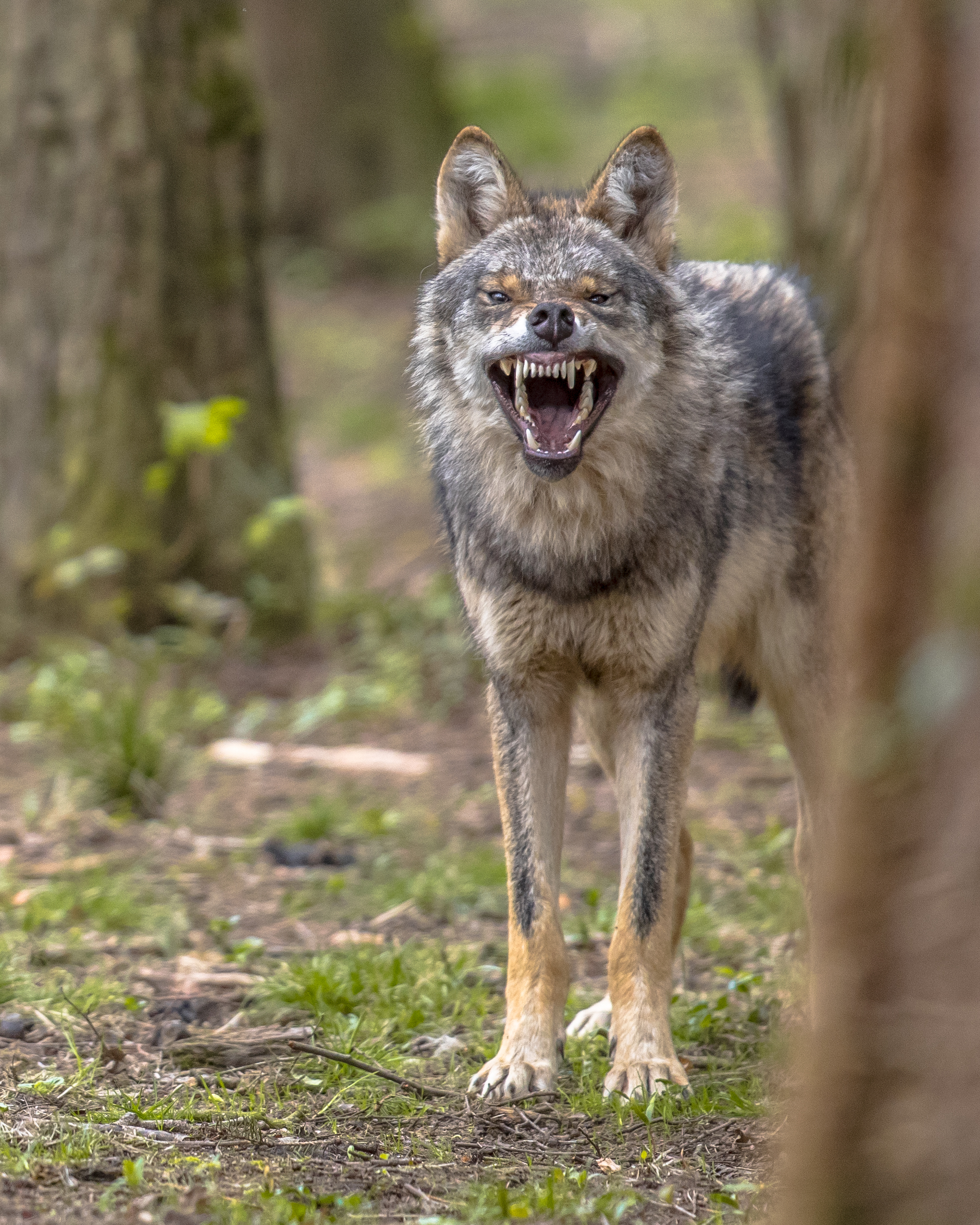
A rabid coyote menaced Archangelo Liberatore and his family at a park in Mount Pleasant. (Shutterstock)
A Fight to the Death
On April 29, 2018, Archangelo Liberatore, an Irvington police officer, was off-duty. He went for a run to prepare for an agility test for the Air National Guard, where he’s a loadmaster on C-17s, before meeting his wife and two kids at James M. Carroll Park in Mount Pleasant, near their home. The playground sits about 100 yards from the baseball field, and behind it is an expanse of woods.
It’s there, Liberatore says, along the tree line, that he first saw the coyote, “trotting along the ballpark from one end to the other.” While he hadn’t seen one in the park before, he knew they were around: “I’d heard of little dogs and cats disappearing. Somebody on a Facebook group posted a screenshot of a coyote in Hawthorne.”
Suddenly he saw the coyote turn and start sprinting toward the playground and the families. “Somebody screamed, ‘Run!’ My wife grabbed one kid, I grabbed the other. I threw him over my shoulder and ran up this little hill to our car. I made it, but then I heard this woman screaming. I looked over my shoulder and saw her on the ground, with her two kids and this coyote shaking a pink blanket. I told my son, ‘Run to mom!’ Next thing I remember, I’m on top of this coyote. I looked up at the mother and yelled, ‘Get out of here, I don’t know how long I can hold this thing!’”
The girl’s mother would later tell the New York Post, the coyote “was like a cheetah. I took my foot and I kicked him as hard as I could in his face, which knocked him to the ground…. When he got up, he swung over to my daughter’s side and bit her arm.”
Liberatore is trained in jiu-jitsu, a martial art that emphasizes pinning an opponent. “I spent the next ten minutes holding this coyote down. I’m strangling it; my hands are around its neck and I’m straddling it.” By this time he’d assumed it was rabid, and he had no choice but to try to kill it.
“It felt very primal. I’d never killed in my life before, an animal or anything. I’m not a hunter, but having the mindset that I have to put this thing down—it was a different place. I was watching it expire right in front of me—eyes rolling back, breathing really shallow. It came close to dying. Then I had a moment where I couldn’t fully commit.”
Up by the car, his wife had called 911. When police arrived, Liberatore identified himself as an off-duty cop and they made a plan: “I jumped off the coyote and they shot it.” Both he and the child, whose arm was bitten, required a series of painful rabies shots. The coyote indeed tested rabid.
Liberatore received several medals for heroism, including the Carnegie Medal, awarded to “individuals… who risk their lives to an extraordinary degree saving or attempting to save the lives of others.”
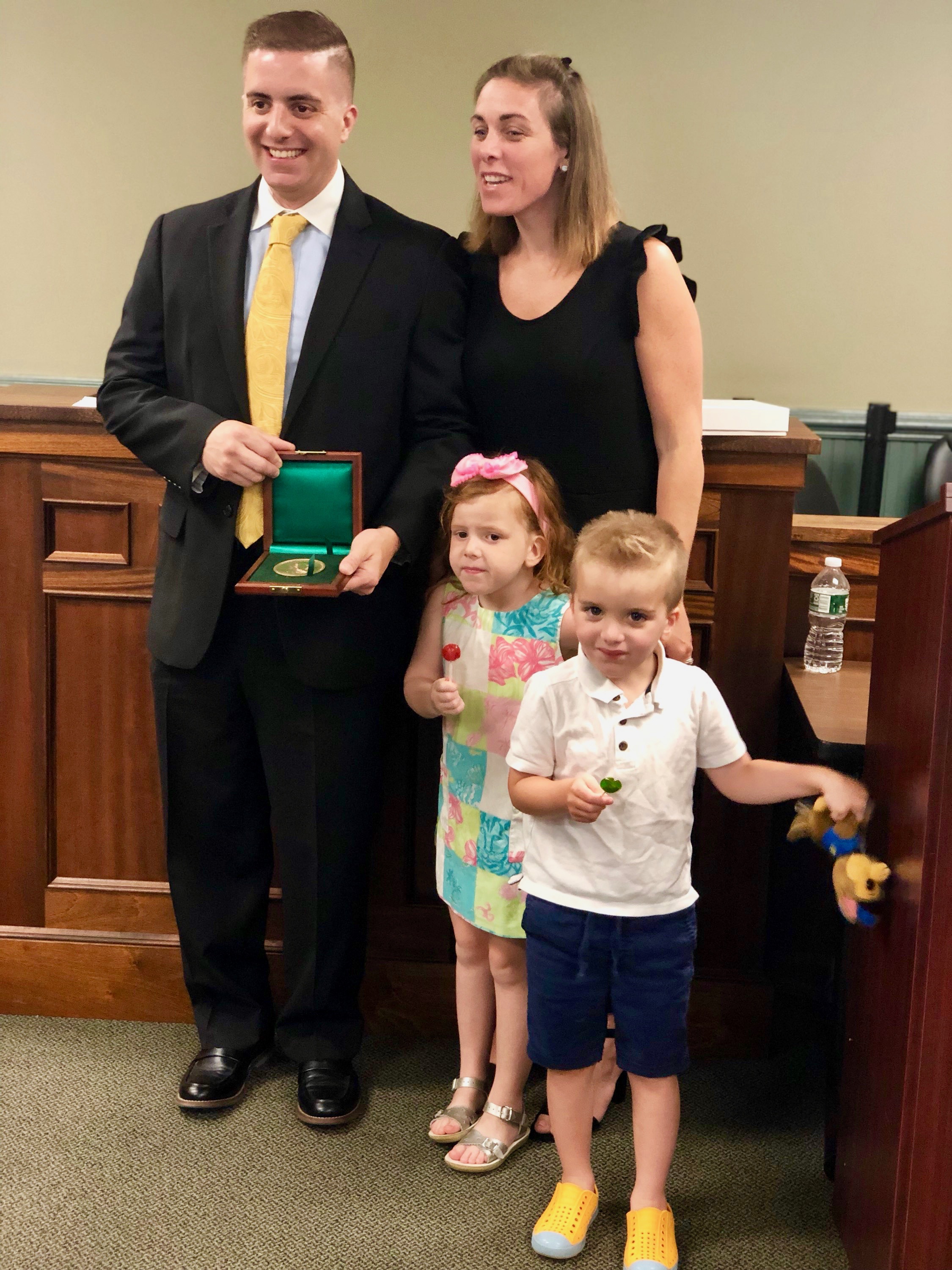
Irvington Police Officer Archangelo Liberatore received the Carnegie Medal for heroism after saving a child from a rabid coyote in Mount Pleasant. (Photo: Archangelo Liberatore)
Liberatore and his family have since moved to Putnam County, and his critter antennae are way up. “I’m a little more vigilant now when I see a wild animal. The more we build into these wooded areas, we’re going to have that happen. In California, they have mountain lions. A month or so ago I was walking my dog and there was this fox making this weird sound I’d never heard a fox make. I don’t know if it was a mating call. I’m like, ‘Here we go again, another rabid animal.’”
Ever the guardian, he drove around his apartment complex warning dog-walkers about the weird fox. “This one guy said to me, ‘It’s just nature being nature.’ I replied, “You know, you’re right.”
The More You Know…
Dana Goin works hard to replace fear with facts. The Sleepy Hollow native, who has a degree in Wildlife Conservation from the University of Delaware, studies large carnivores. She got her start as an intern at the Wolf Conservation Center in South Salem, where she now works as a Wildlife Outreach Specialist. Goin’s presentation about the Eastern coyote is a must-see for municipalities looking for coexistence strategies.
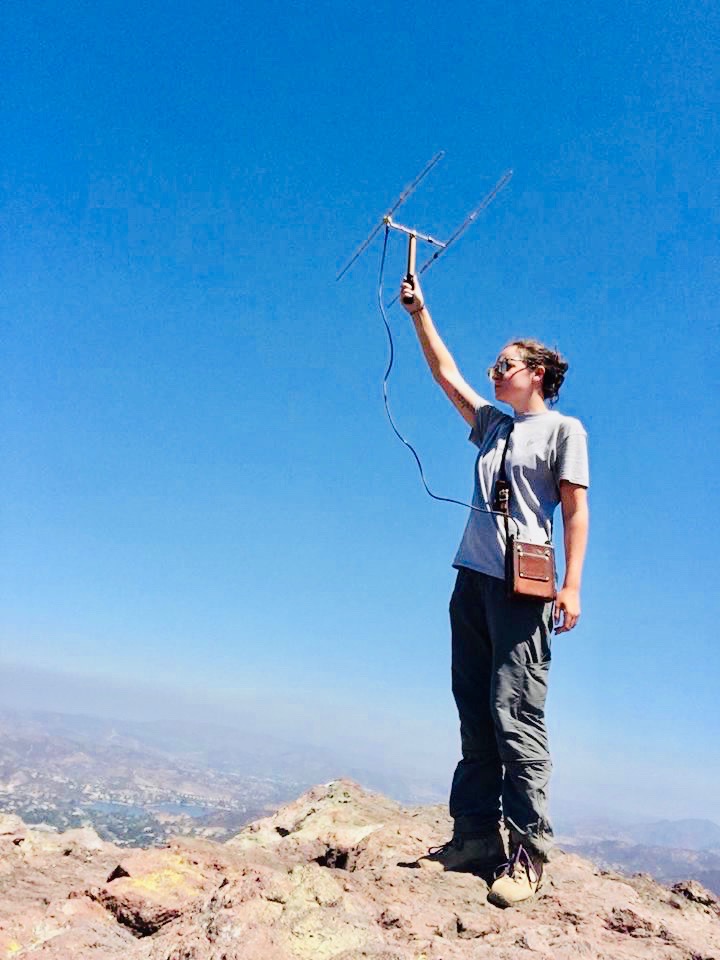
Dana Goin, Wildlife Outreach Specialist at the Wolf Conservation Center, educates the public on coyote behavior. Here, she’s conducting radio telemetry to triangulate mountain lion locations in Southern California. “I’ve loved animals my entire life and am grateful I get to work toward making the world a more peaceful place for them.” (Photo: Dana Goin)
“Coyotes need a new PR rep,” she admits. “People are wary of them, but they’re not going anywhere.”
Last March, Goin presented on Zoom to Rye Brook town hall as part of its first Coyote Information Exchange. Rye Brook is the Wolf Conservation Center’s first Coyote Wise Community, a proactive approach to “mitigating human-coyote conflict, ultimately improving coexistence.” The village has also posted an excellent guide to demystifying coyote behavior (ryebrook.org). It’s part of a long evolution that was sparked in 2010 when a rabid coyote attacked several people in Rye Brook. A police officer shot the animal under a backyard trampoline. The village hired trappers for a year but then shifted to educating residents on coexisting with them.
“We’ve evolved like everybody else,” says Village Administrator Chris Bradbury. “The more information we put out to the community by providing resources and staying on top of the issue, the more it benefits coyotes and the people living with them.”
Bradbury reports that since the March forum, Coyote Incident Reports have stopped. But social media remains a prime driver of the man/beast debate, for better or worse. A recent thread about a bobcat in New Castle, with a photo of said big cat and the comment “Watch your small animals,” went like this:
“Wow! So gorgeous!”
“I really wish you didn’t post where you saw it. Now, some yahoo is going to go and trap/kill it.”
“I agree, people are ruthless. But on the other hand, I’d appreciate the heads up if I lived nearby with our 3 dogs. I try to warn my neighbors every time we have coyotes and bobcats in our yard.”
“Beautiful! Bobcat! I’d love to see one. But with coyotes a much bigger threat, one should always be careful of pets.”
“Bobcats hunt small prey: mice, chipmunk, squirrel, etc. Most pets would not be of interest to them. Coyotes are another story but they serve a purpose as well.”
The author of that last post, Susanne Pandich, lives in a well-populated neighborhood in Chappaqua. Her backyard could star in Wild Kingdom: Chappaqua Edition, and she likes it that way. “I’ve seen wild turkeys, a bobcat, red-tailed hawks,” she says, pointing to her yard. “The deer was there. The coyote walked right across the lawn. This past winter I had a goshawk; it’s a much bigger hawk, very fierce! He sits on my gas grill watching the bird feeders, waiting to get a few little birds — like I’ve arranged a buffet for him. I haven’t seen a squirrel since that hawk moved in. In nature, there’s always something bigger than you.”
Pandich, whose career involved managing large tracts of land, is clear-eyed on the realities of the natural world. When she walks her dog, she wears a coyote horn — a green plastic tube — more a bombastic whistle than a horn–on a lanyard, available for free at New Castle Town Hall. On the side, it reads: “Email coyote questions to Coyote@MyNewCastle.org.” Making loud noises — yelling, banging pots and pans, blasting an air horn — is called “hazing,” and it’s recommended for scaring off coyotes. Pandich has never had occasion to use the horn, and probably wouldn’t, even if she saw one: “It’s very rare that a coyote would confront you.”
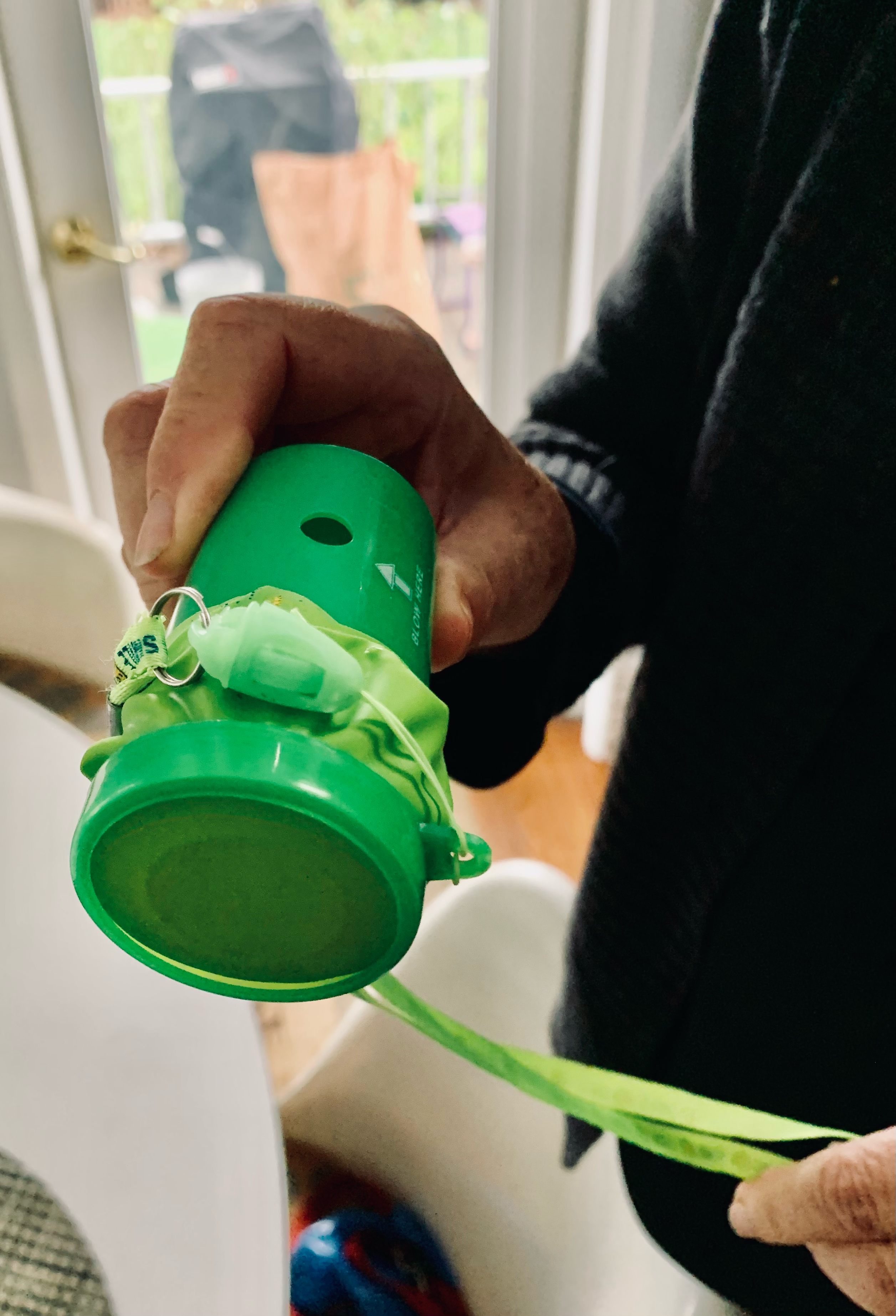
New Castle provides coyote horns to residents for hazing a coyote that may cross their path. (Photo: Dana White)
She calls herself “pro-predator,” and feels it’s people who must make the man/beast relationship work. “It’s up to humans to adapt,” she says. “We need to take responsibility. If you’re going to let your cat stay out at night, you may lose it. If you’re worried about coyotes, act on it. Take some sort of precaution. Don’t be a victim.”
The problem, as she sees it, is that “we don’t have enough predators. And God knows we need some. We’re inundated with deer, and it’s dangerous. I drive down the Sawmill and they’re grazing on the side of the highway.”
Our apex predator? “In Westchester County, it’s the car.”
The Tragic Case of Bear 211
Bears seem to occupy a soft spot in our hearts. Perhaps they remind of us our teddy bears or our favorite Yogi Bear cartoon. We cut them way more slack than we do coyotes. Bears that migrate down to Westchester County tend to be young males from western Massachusetts who have left their mothers and are fending for themselves until they head back up north to find a mate. Their numbers are still small. And they are the most likely to get in trouble.
Bear 211 fit the profile. The fluorescent pink ear tags bearing the number CT 211 indicated he was a “problem bear” tagged in Connecticut, where he spent most of his time, aside from occasional forays into northern Westchester, particularly Armonk. He was a year-and-a-half old and had developed a taste for human food, which he found in abundance, raiding bird feeders and trash cans. People began feeding him on purpose. He became “habituated,” and lost his fear of humans.
Bear 211 gained a following, and in late May of this year, a Facebook page was established, in the tradition of Mr. Scrabbles, the Chappaqua bear, where his fans could post and share their sightings. Almost 6,000 people joined. His ursine shenanigans—floating in swimming pools, swinging in hammocks, showing up uninvited at a child’s birthday party — provided, as one commenter put it, “a distraction from political nonsense and the virus,” a “guiding light” to rally around.
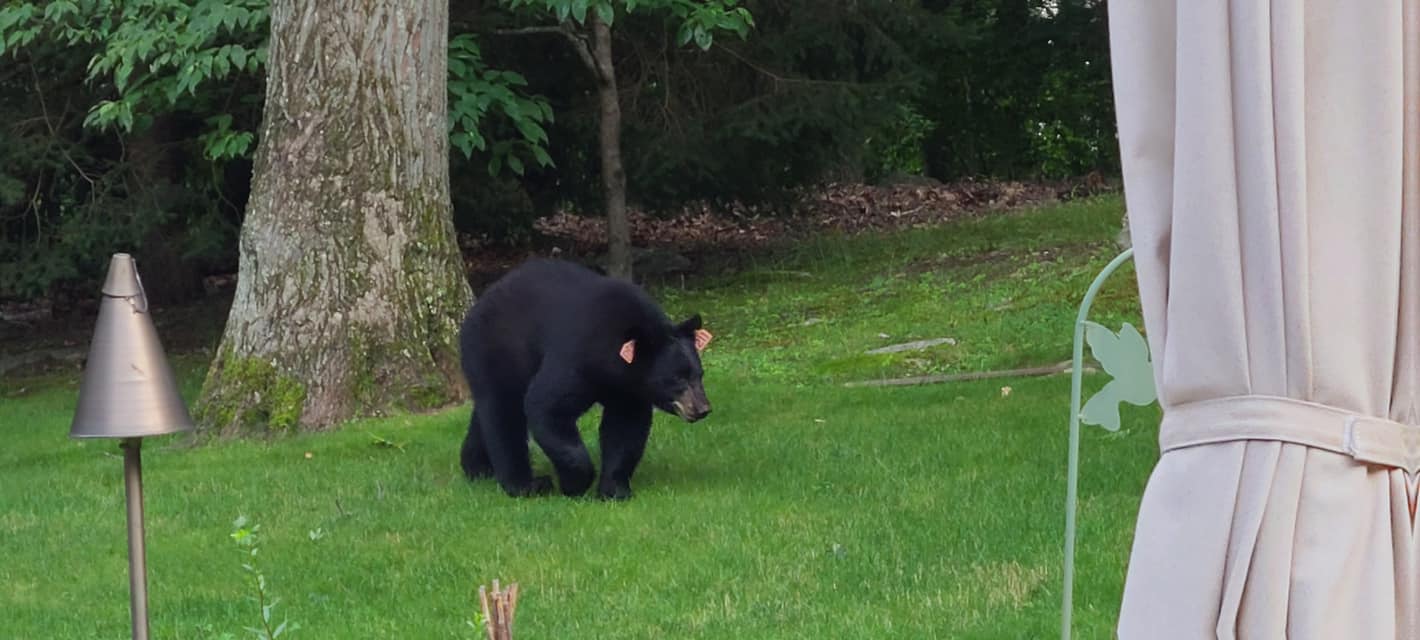
Bear 211 in one of his many backyard sightings.
But wildlife experts were watching with concern. “He was still learning; it was a dangerous time for him,” says Dana Goin. “I thought, ‘This bear is way too comfortable around people.’ There’s a saying, ‘A fed bear is a dead bear.’”
Budd Veverka, Director of Wildlife Management at the Mianus River Gorge in Bedford, agrees. “The more it became habituated, the more it was going to be in suburban areas, crossing roads, breaking into houses. It was not going to turn out well.”
On July 28, around 6:30 in the evening, Bear 211 was crossing Rte. 136 in Easton, Ct., when it was hit by a car. Grievously wounded, he had to be euthanized. Members of his Facebook page mourned his loss, pouring their grief out in emotional posts. Even People.com reported on the passing of this “social media sensation.” Tributes to Bear 211 continue on the site, which remains up.
Goin offers this advice: Keep wildlife at arm’s length. Never feed them. “The best way to honor Bear 211 is to protect other bears like him. We need to reinforce their fear of people…. Even though it feels really counterintuitive to animal lovers, they want their backyards to feel like a safe haven, they want them to have a full belly. But if we want our wildlife to have long, happy, safe lives, the best thing we can do is keep them wild.”
Dana White is a freelance writer living in the village of Ossining, where she shares her yard with raccoons, skunks, squirrels, and an opossum that has snuck into the house twice.
We hope you’ve enjoyed today’s section of Examiner+. We love honest feedback. Tell us what you think: examinerplus@theexaminernews.com

Examiner Media – Keeping you informed with professionally-reported local news, features, and sports coverage.
